Passed down from my British great-grandmother, this authentic English scones recipe is easy and delicious… plus traditionally prepared with sprouted flour so it’s extra healthy! Serve with fruit jam and butter for a classic afternoon tea in England, or probiotic Devonshire cream if you want a flavorful twist.
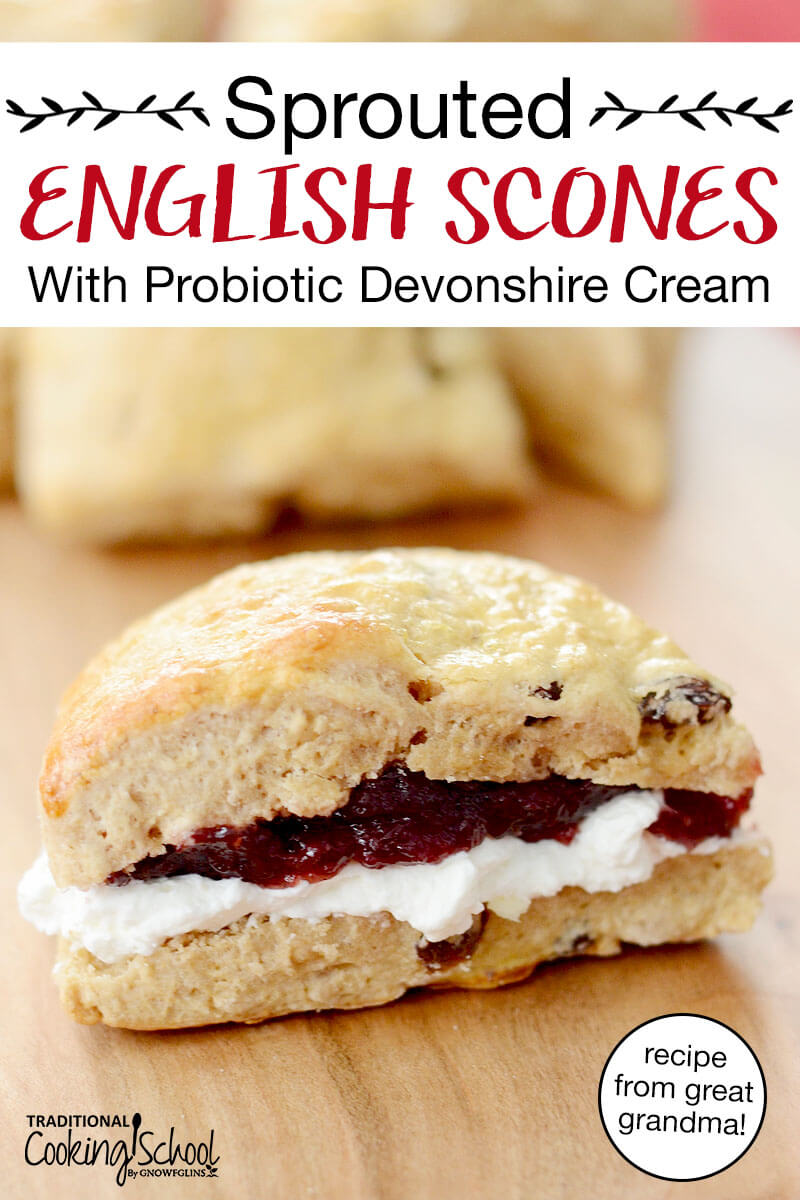
Do you have a treasured family tradition?
My great-grandfather and great-grandmother were originally from a small town near Leeds, England — close to the Scottish border — although they emigrated to the United States in search of a better life when their children were young.
According to family legend, my great-grandmother loved entertaining company. As soon as she heard the latch at the back gate, she would immediately put the kettle on in preparation for any visitors.
I never knew her, but I deeply appreciate her sense of hospitality, and her British tradition of serving tea and scones!
In fact, over 10 years ago, I and a bridesmaid baked hundreds of these scones for my high tea wedding reception. They are easy to make and store well!
I’ve adapted the recipe below to include nourishing ingredients and traditional preparation methods such as sprouting grains.
Feel free to add raisins or currants into the dough. I like to use cream or butter with homemade jam or curd to top mine.
A traditional high tea also typically serves Devonshire (or clotted) cream with the scones. Since clotted cream requires scalding the milk, I opt instead for a homemade probiotic, enzyme-rich creme fraiche.
If you don’t care for the slight tartness, serve unsweetened whipped cream instead.
Before we get to the recipe, let’s discuss a few important details…
What is a scone?
A scone is a traditional British baked good that may be considered a quick bread.
It is only slightly sweet and is usually served with butter, jam, or cream (or a combination of all three!).
Morning or afternoon tea is the most common time to eat scones, although they often make an appearance at breakfast as well.
Scones are made with wheat flour and use baking powder as a leavening agent. Butter is worked in to the dough and helps create a crumbly texture.
Our recipe is slightly different than a regular British scone recipe in that it uses sprouted flour. We did this to create the most nutrient-dense and digestible option just like in our cinnamon honey spelt biscuits.
What’s the difference between American scones and English scones?
To begin with, English scones are much less sweet than their American counterparts. They may contain currants or other dried fruits, but are generally not stuffed with add-ins.
English scones are often served with jam and clotted cream or a slathering of butter. Some also enjoy a simple topping of jam or preserves, and many first spread with butter, then top with jam.
Perhaps more like American baking powder biscuits than American scones, the English version contains less butter.
It differs from the American biscuit too, in that the butter is completely worked in rather than being left in chunks to make fluffy layers. The English results is meant to be fluffy and slightly crumbly.
Both are delicious, yet different!
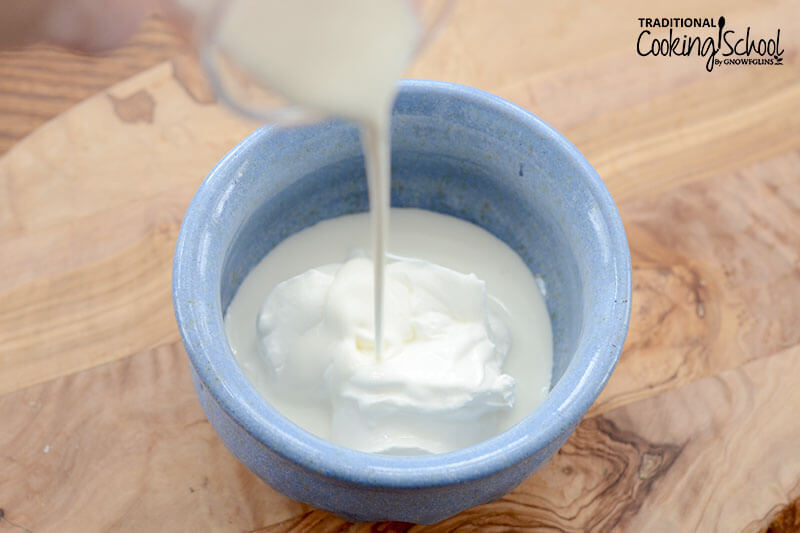
What is clotted cream?
Also called Devonshire cream, Devon clotted cream, or Cornish clotted cream, this indulgent topping in often served with scones.
These names refer to its place of origin, and there is some dispute as to whether the delectable cream was invented in Devon or Cornwall (both are counties in the southwest of England).
With a taste similar to high-quality butter, clotted cream is much less sweet than our American whipped cream. It does have a mild sweetness to it and is often said to taste slightly “nutty.”
Clotted cream is made by heating milk then allowing it to cool slowly. The cream that rises to the surface and “clots” is skimmed off and used to top scones and other desserts. It is also included in traditional cream tea.
Our recipe below is a quick “mock” version which blends sour cream and raw heavy cream. This creates a tangy spread that pairs well with jams or can be used alone.
How To Make This Sprouted English Scones Recipe
When it comes to making English scones, there are a few important steps to ensure the best results.
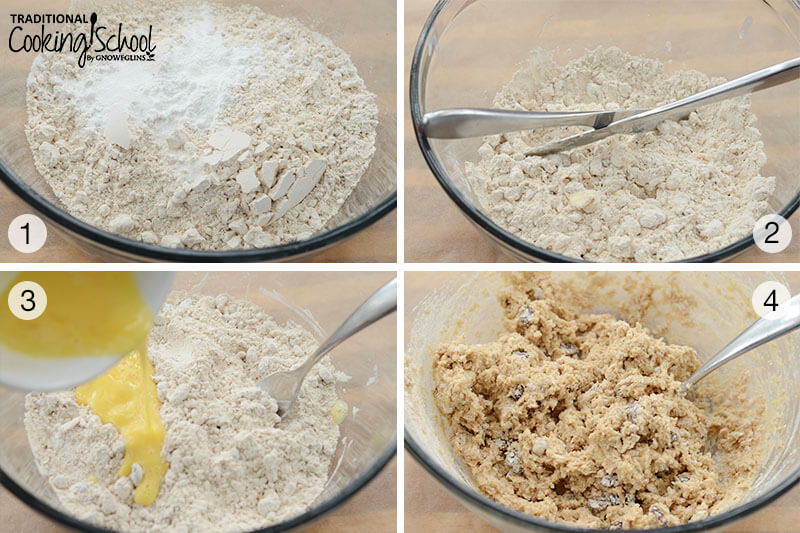
Step 1: Add dry ingredients to the bowl.
This is very basic, I know, but I’m noting it for two reasons:
- Make sure the bowl is big enough to accommodate your hands, should you chose to rub in the butter as directed below.
- Add butter to the dry ingredients on its own, not along with milk or other wet ingredients.
Step 2: Rub in the butter.
You might begin by cutting in the butter with knives or a pastry cutter, but the preferred method is to rub in the butter with clean fingers. This incorporates the butter thoroughly, distributes it evenly, and helps create the traditional crumbly texture.
A food processor also works, just be sure to pulse quickly and stop once the mixture reaches a crumbly texture.
Step 3: Add dried fruit, if desired, and wet ingredients.
Scones are often served with jam and cream and don’t require add-ins of any kind. However, many enjoy the addition of dried fruit, such as currants or raisins.
If including dried fruit, add it after the butter has been rubbed in.
After adding the dried fruit, pour in the remaining wet ingredients.
Step 4: Stir!
Stir until well combined. Don’t overwork the dough.
It should be sticky, but not so sticky it will stick to your hands.
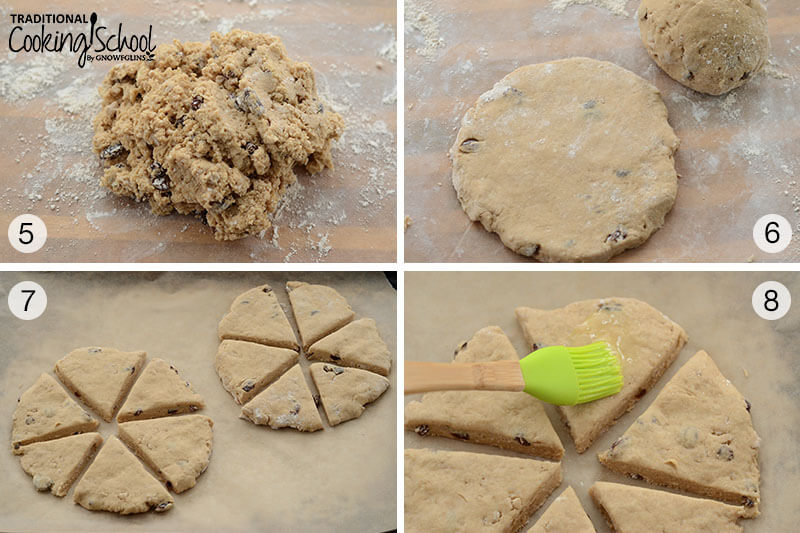
Step 5: Turn out on floured surface and knead briefly.
Knead only until the dough comes together. Don’t handle the dough too much!
One of the most important rules you need to know when making English scones is to handle the dough as little as possible to prevent it from becoming tough.
Now, I know! I just told you to rub in the butter, which requires a lot of hands-on time. Once the scones reach the “dough” stage, though, it’s important not to over-work them.
You will notice a kneading step in the recipe below, but be sure to knead only as much as necessary and no more.
Step 6: Press down or roll to 1-inch thick.
If cutting into wedges, divide dough in half and roll out or press down into 1-inch thick circles.
If you prefer to cut into circles with a biscuit cutter, roll into one large rectangle.
Step 7: Cut into shapes.
Traditionally, scones are cut into rounds. Press a cookie cutter, biscuit cutter, or glass into dough to cut out shapes.
Place on a parchment-lined cookie sheet or baking tray.
Or, if you’d like to cut the scones into wedges instead, take the 1-inch thick circles you created above, and place them onto a parchment-lined cookie sheet or baking tray.
Slice each circular round into 6 slices. Start by cutting one slice across the diameter, then two diagonal slices to create 6 triangle shapes (see picture).
Step 8: Brush tops with milk or beaten egg.
This provides a beautiful golden color. Don’t skip this step as it makes the most delightful looking (and tasting) scones.
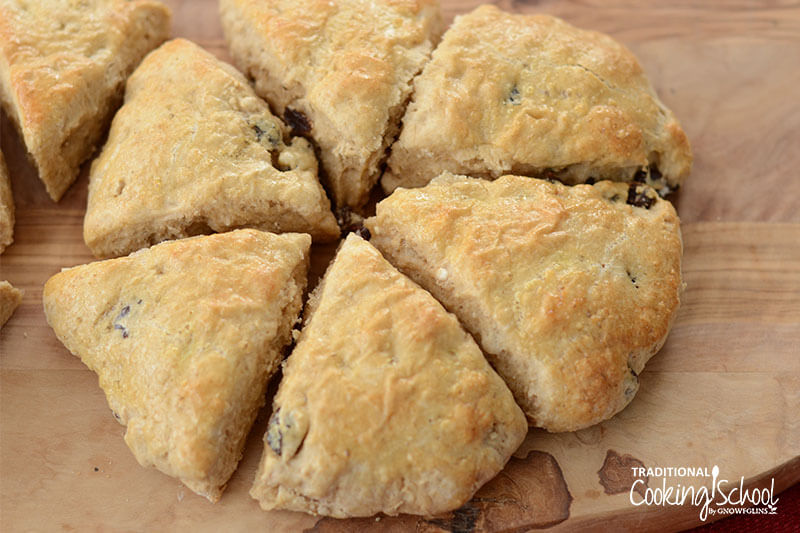
Step 9: Bake!
Bake scones in a hot oven for a short amount of time. Our recipe bakes at 425 degrees Fahrenheit for only 12 to 15 minutes.
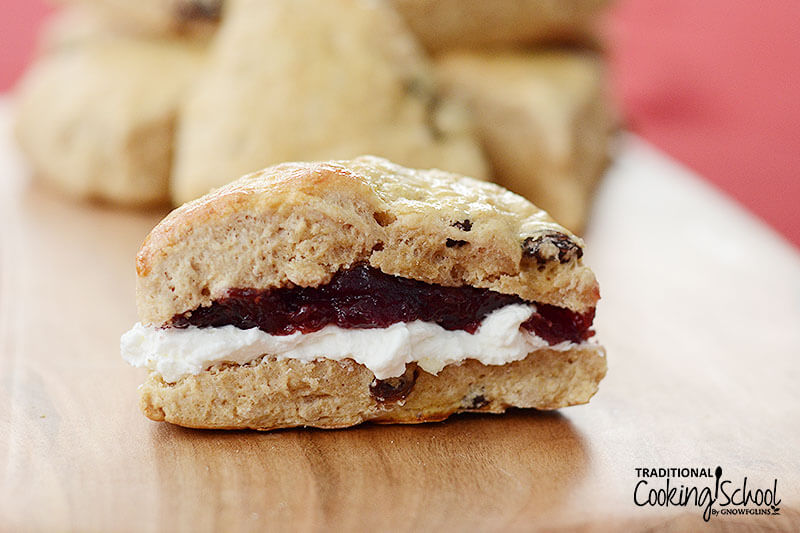
Step 10: Serve with cream, jam, and/or butter.
Slice scone and spread with cream and jam or a slathering of butter.
The mock Devonshire cream recipe below is full of probiotics and extremely delicious, but you may also use unsweetened whipped cream for a quick and easy option.
Sprouted English Scones Recipe
Our recipe below embraces the essence of a traditional English scone but makes some adjustments to make it more nourishing and nutrient-dense.
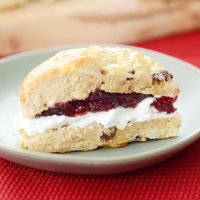
Sprouted English Scones
Passed down from my British great-grandmother, this authentic English scones recipe is easy and delicious... plus traditionally prepared with sprouted flour so it's extra healthy! Serve with fruit jam and butter for a classic afternoon tea in England, or probiotic Devonshire cream if you want a flavorful twist.
Ingredients
- 2 cups sprouted whole wheat pastry flour
- 1 tablespoon baking powder
- 1/4 teaspoon sea salt
- 1/3 cup dried raisins or currants, optional
- 6 tablespoons grass-fed butter unsalted
- 2 organic or pastured eggs divided and each beaten separately
- 3/8 cup cultured buttermilk
- 2 tablespoons maple syrup
Instructions
-
Preheat oven to 425 degrees Fahrenheit.
-
In a large mixing bowl, stir together the flour, baking powder, and salt.
-
Using a fork or pastry cutter, cut in the butter until the mixture resembles coarse crumbs. Or, rub the butter in with clean fingers. This works the butter in thoroughly, distributes it evenly, and helps create the traditional crumbly texture.
-
Stir in raisins or currants (if using).
-
Add 1 beaten egg, buttermilk, and maple syrup.
-
Stir just until the dough comes together.
-
Knead gently on a lightly floured surface, about 12 to 15 strokes.
-
Divide dough in half and shape each half into a ball on a parchment paper-lined or lightly greased baking sheet.
-
Roll or pat into a 6-inch circle, about 1-inch thick.
-
Cut each circle into about 6 small pie-shaped wedges.
-
Brush top of scones with the other beaten egg and bake until deep golden brown, about 12 to 15 minutes.
-
Serve with probiotic Devonshire cream (see recipe notes, below) and homemade jam!
Recipe Notes
Probiotic Devonshire Cream
Combine 1/2 cup heavy raw cream and 1/2 cup sour cream. Cover and set in a warm place until thickened, anywhere from 8 to 24 hours. Refrigerate.
Not sure how to get sprouted flour? This quick and easy tutorial will teach you how to sprout grains!
Flavor Options For Scones
As mentioned above, traditional English scones recipes do not include many add-ins, so we are departing from tradition a little here. But these flavor options are incredibly tasty!
To use any of the following, first omit the currants called for in the original recipe:
- 1/3 cup dried cranberries + 2 teaspoons orange zest
- 1/3 cup fresh blueberries + 1/2 teaspoon vanilla extract
- 1/3 cup chopped dates + 3 tablespoons chopped walnuts
- 1/3 cup fresh blueberries + 1 teaspoon lemon zest + 1/2 teaspoon vanilla extract
- 1/3 cup chocolate chips
How To Freeze Scones
Freeze unbaked scones individually, after cutting into shapes.
This allows one to bake scones as needed. Just pull out as many as desired than bake from frozen.
Or, freeze already baked scones. Simply wrap well and store in freezer for up to 3 months.
Can I make scone dough ahead of time?
Yes! Prepare scone dough one day in advance and store in the fridge.
Some suggest this actually makes a better scone!
Will you try this English scones recipe? Have you ever had Devonshire cream or scones with sprouted flour?
This post was originally published and written by Jenny Cazzola on 3/13/14. It was updated and republished on 2/7/20.
We only recommend products and services we wholeheartedly endorse. This post may contain special links through which we earn a small commission if you make a purchase (though your price is the same).


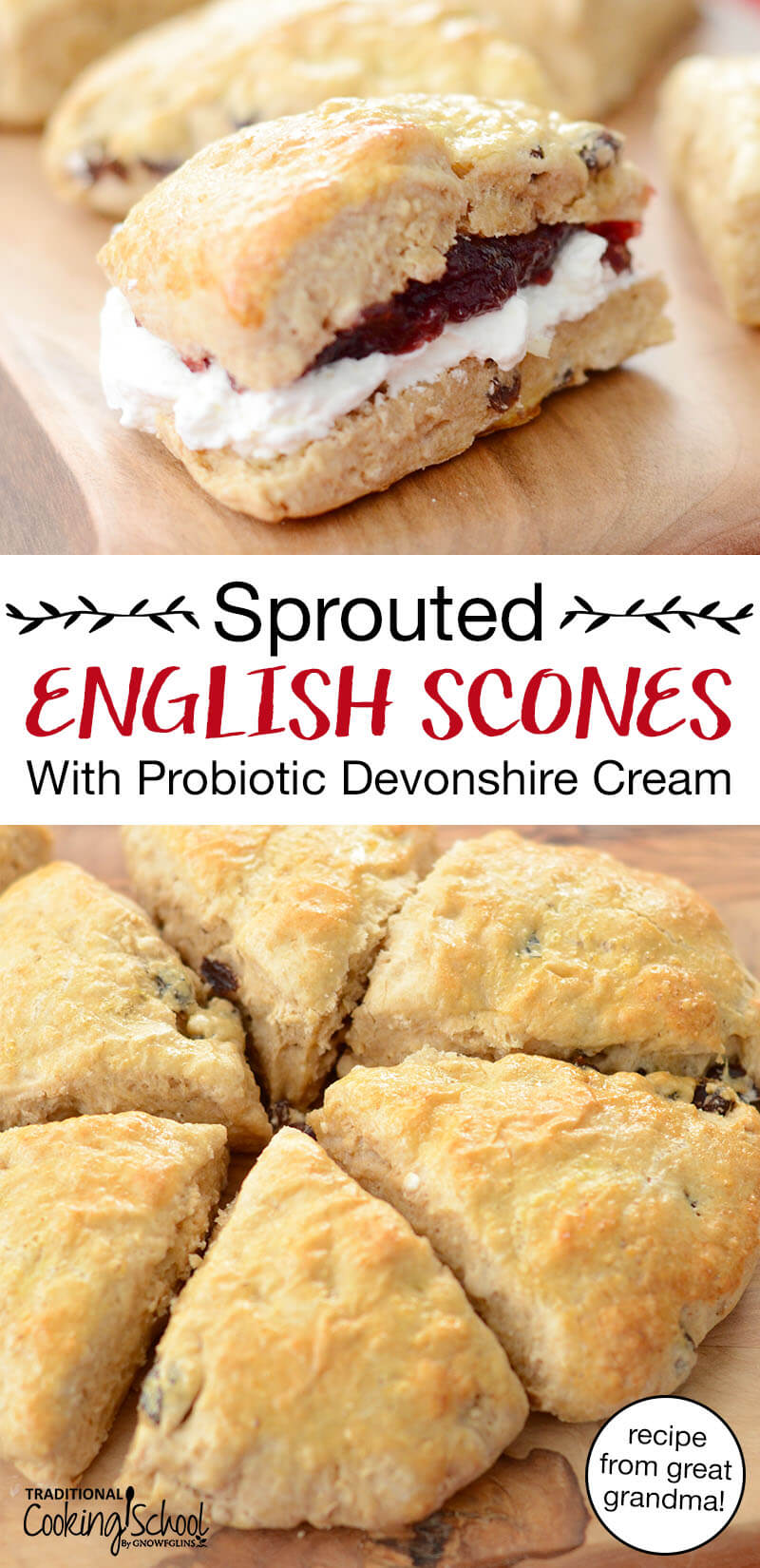
Jenny, I couldn’t wait to make these scones! So I did — for lunch, today. I used sprouted emmer flour and omitted the sweetener entirely. Didn’t have buttermilk so I used raw milk (from the creamy top of the jar). They turned out fabulous. Thanks for the great recipe! 🙂
I’ve made them with “sweet” milk many times; even cream. I’m glad you enjoyed them!
Hi Jenny
Will add this to recipes of scones as I am in the UK.
Yes we have clotted cream which I have to say is delicious . . . however will try the creme fraiche.
And I always leave out sweetener in scones or dessert pastry too.
Thanks
K
Clotted cream is tasty! I hope you enjoy the creme fraiche just as much. I found it to be a pretty decent substitute.
I’ll try this! I just made scones for our local library’s annual tea, and looked for a simple recipe for Devonshire cream. Many began with, “Start with the cream from a Jersey cow…”
I did find something that worked, but I’ve marked this for next year.
Thank you!
Thanks Meredith! I hope you enjoy them.
When you make the mock Devonshire cream, is it ok to leave the cream and sour cream out if I don’t have raw?
This sounds wonderful and I can’t wait to make it! Thanks!
Katie, Do you mean leave them out at room temperature? Or delete them entirely? The raw cream has the needed bacteria which will help the final result to set up properly. If the cream is ultra-pasteurized, it won’t work. 🙁 I would recommend using the heavy whipped cream as an alternative instead-does that make sense? Let me know if you have any further questions and good luck with them!
That’s exactly what I was wondering (leaving it out room temp). I had a feeling that wouldn’t work. Thank you so much!
I would encourage the unsweetened whipped cream then. That is my personal favorite. 🙂
Thanks!
Will be giving these a try. You drew me in with the line that your Grandpa was born near a small town near Leeds. My Grandmother was born in Ossett and then emigrated with her family to Australia. Prize winning scones still come from our home. 🙂
Really Robyn? That is so cool. Is your recipe pretty much the same then?
…I’d be interested to know too how you shape them. I’ve always just done the wedges but I know they can be dropped (like drop biscuits) or cut into rounds.
I have a couple of favourite recipes. Pumpkin scones and lemonade scones are my two favourite. My basic scone recipe I often whip up uses up the cream that cream that is almost at the end of its shelf life and I substitue the butter and butter milk. So my basic recipe is SR Flour, a pinch of salt and the cream. Traditional recipes rub butter into the flour and then moisten with milk. Scones are still judged as favourites at Agricultural Shows (Fairs I think the US refers to them as) and they are definitely an exact art. Here the are cut into rounds with a scone cutter and spaced a little apart and brushed with a little milk before being placed into a hot oven. When we used to go camping as children, Mum would often make drop scones in a hot pan (skillet) over the camp fire. Yum!
Oh I’ve never heard of lemonade scones! Those sound lovely. The scones for my wedding were small and round but we just used a standard biscuit cutter for them. Now I think I’d like to have a scone cutter. I didn’t know there was such a thing. I’ll have to go shopping.
A few questions w/ clotted cream:
1) What’s the difference b/w clotted cream and creme fraishe?
2)If I culture whipping cream (I don’t have access to raw), what is that? I’ve been doing that, and it tastes fairly similar to sour cream. .. .
3) How can I culture whipping cream to make it taste more dessert-like instead of taste like sourcream?
4) Can I use my cultured whipping cream in your clotted cream recipe, and what would it substitute? the cream or the sourcream?
Thanks so much!
Clotted cream is made by heating double cream (heavy cream) ion a high heat. It makes it very thick.
Creme fraishe is cream that has been cultured to give a sour flavour (and probiotic goodness).
When you culture any cream it is sour cream. Pasteurised cream cultures fine but the raw ia always best for your health.
As far as I can see adding the cultured cream to the raw cream just makes a double helping of sour cream.
What Patricia said. As far as substitutions, if your cultured whipping cream is already thick, I would just use it as it is. 🙂
Very nice recipe. Thanks for sharing